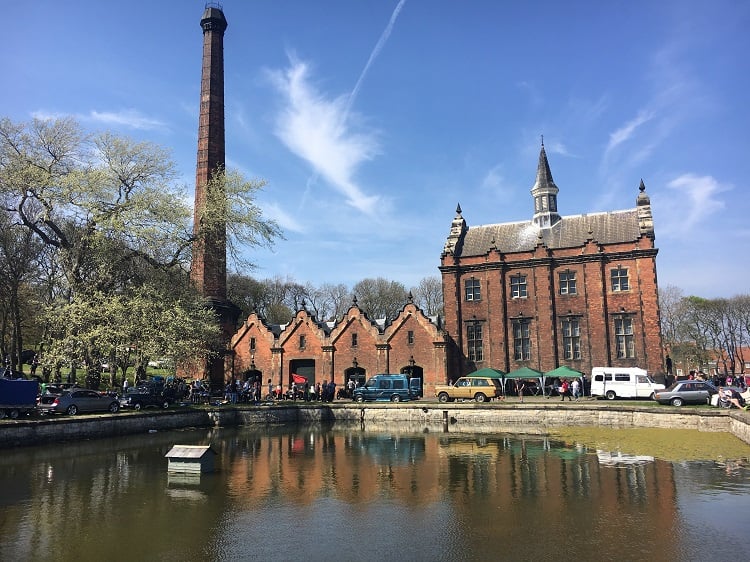
We are incredibly proud of our Historic Museums and the fine industrial heritage they represent.
By working in partnership with the three groups of volunteers, we are able to get a glimpse of how Victorian waterworks operated and preserve them for generations to come. The volunteers do an amazing job and the open days allow visitors to visitors take a look behind the scenes - seeing first-hand the mechanical marvels such as the giant engines and water pumps in action, as well as the iron work demonstrations in the smithy.
Ryhope
Ryhope Engines Museum, owned by Northumbrian Water and ran by the volunteers of The Ryhope Engines Trust, was built in 1868 and once supplied drinking water to Sunderland and the surrounding areas for 100 years and has operated as a museum for over 50 years.
The Museum is now regarded as one of the finest single industrial monuments in the North East of England and is both a Grade II* listed building and an Ancient Scheduled Monument.
The museum generally opens to the public for steaming events on Bank Holiday weekends, when visitors can see the site in full operation - thanks to dedicated volunteers who help Northumbrian Water preserve it. The site also opens to the public as a static exhibit every Sunday, from Easter until the end of December, between 2.00pm and 5.00pm.
Visitors can see two 100 horsepower beam engines built by R & W Hawthorn, three 'Lancashire' boilers dating from 1908 (two of which are in regular use), a blacksmith's forge with demonstrations, a waterwheel, numerous steam engines, pumps and waterworks accessories.
Keith Bell, Chairman of Ryhope Engines Trust, said: "Our volunteers work hard throughout the year and are the life blood of the ongoing preservation project at the museum. We not only run the museum on a day-to-day basis but also manage the Trust and plan for the future.”
The site also holds around five steaming weekend events every year, giving visitors the rare chance to see this Victorian waterworks in action under steam power.
Tees Cottage
Tees Cottage Pumping Station, built in 1849, once provided drinking water to Darlington and the surrounding areas of Teesside, until it was converted into a museum in 1980.
The volunteer-run museum now opens as a static exhibit every Wednesday, when volunteers meet to do tasks, and hosts around five steaming events every year, giving visitors the rare chance to see this Victorian waterworks in action.
For the last 40 years, Northumbrian Water and the volunteers have worked in partnership to preserve this historic landmark in Darlington, with volunteers donating around 25,000 hours every year to this scheduled monument.
There is much more to volunteering at this scheduled monument than maintaining and fixing engines, with volunteers sought after to help out with STEM school visits, social media content planning, event management, finance, administration, gardening, meeting and greeting visitors, baking food and helping serve in the tea room during public opening weekends.
Darlington-born George Beautyman, who has been a volunteer at Tees Cottage Pumping Station for 38 years, said: "It's a pleasure to be a part of this team - I have made some life-long friends since volunteering and learned so many new skills over the years. I love meeting new people and helping to preserve this industrial heritage right here in the North East."
The Museum of Power
The Museum of Power in Langford, Essex, welcomes thousands of Visitors each year as well as many of our colleagues, who volunteer to do improvement works there as part of our ‘Just an Hour’ Scheme.
We are proud to support this valuable asset for the local community, which contributes to our social capital.
The museum’s setting is the 1920s Langford steam pumping station – now a Scheduled Ancient Monument.
Its star exhibit is a 1931 steam engine called ‘Marshall’, the sole survivor of three engines that supplied most of Southend’s drinking water until they were replaced in 1963 with three semi-automatic, electrically-operated versions. Marshall was returned to steam operation for the first time in 50 years in April 2011, thanks to the hard work of a dedicated team of volunteers. As a result, the Institution of Mechanical Engineers awarded the museum ‘Engineering Heritage Listed Status’ in 2013.
The original works, which were designed to provide a daily supply of seven million gallons of drinking water, were closed in the late-60s when new facilities were built on the same site. They then lay unused until 1996 when ESW, Maldon District Council and museum organisers collaborated and got the go-ahead for a visitor attraction.
Set in seven acres of grounds, with the River Blackwater running through, the museum is home to a fascinating array of power-related exhibits, as well as a model village and miniature railway. It hosts a number of special themed events throughout the year, as well as regular school visits.
Dick Waylen, a Trustee of the Museum of Power said: “We are incredibly proud to welcome thousands of visitors to the Museum of Power every year, and we are grateful for the support from Essex & Suffolk Water which allows us to operate in such a fantastic location. It is wonderful to be able to bring our fascinating industrial heritage to life, and hopefully this will inspire generations for many years to come.”
